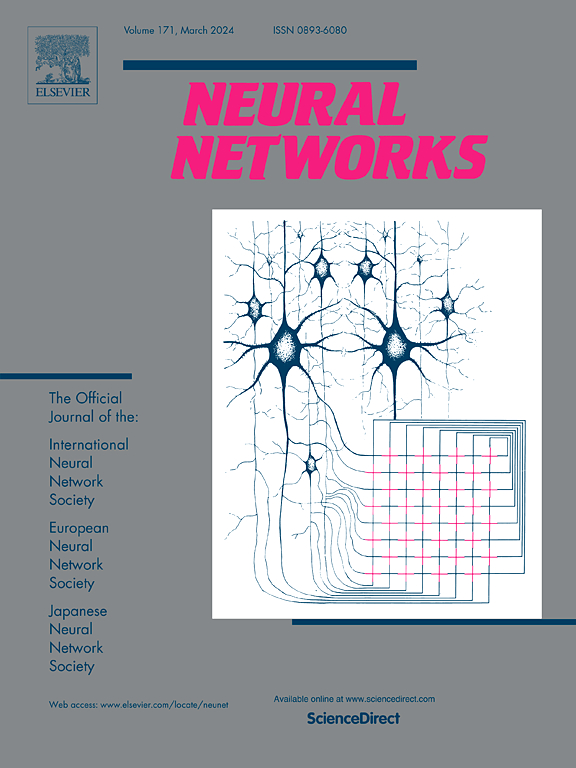通过扩散跳跃 GNN 实现异嗜系统中的节点分类
IF 6
1区 计算机科学
Q1 COMPUTER SCIENCE, ARTIFICIAL INTELLIGENCE
引用次数: 0
摘要
在虚构 GNN 的理想(嗜同)状态下,属于同一社区的节点具有相同的标签:大多数节点都是谐调的(它们的未知标签是在给定了一些标签节点的情况下,对其邻居的未知标签进行平均的结果)。换句话说,异质性(当相邻节点具有不同标签时)可被视为 "和谐性的损失"。在本文中,我们用网络的谐调性(拉普拉斯 Dirichlet 能量)与其同亲版本的谐调性(所谓的 "地面 "能量)之间的比率来定义 "结构异亲性"。这种新的测量方法启发了一种新颖的 GNN 模型(扩散-跳跃 GNN),它通过在网络中 "跳跃 "来绕过结构异质性,从而将遥远的同源物联系起来。不过,我们的跳跃不是像标准的高阶(HO)GNN(MixHop)那样使用跳数,而是以众所周知的结构度量为基础:扩散距离。计算 "扩散矩阵"(DM)是这一方法的核心。我们的主要贡献在于,我们既学习了扩散距离,也学习了由扩散距离衍生出的 "结构过滤器"。由于扩散距离具有频谱解释,因此我们可以学习拉普拉卡特征向量的正交近似值,同时使预测损失最小化。这就导致了捕捉低频内容的 Dirichlet 损失和细化该内容的预测损失之间的相互作用,从而产生了经验特征函数。最后,我们的实验结果表明,无论是在同亲数据集还是异亲数据集中,即使是在大型图中,我们都能与最新技术(SOTA)相媲美。本文章由计算机程序翻译,如有差异,请以英文原文为准。
Node classification in the heterophilic regime via diffusion-jump GNNs
In the ideal (homophilic) regime of vanilla GNNs, nodes belonging to the same community have the same label: most of the nodes are harmonic (their unknown labels result from averaging those of their neighbors given some labeled nodes). In other words, heterophily (when neighboring nodes have different labels) can be seen as a “loss of harmonicity”.
In this paper, we define “structural heterophily” in terms of the ratio between the harmonicity of the network (Laplacian Dirichlet energy) and the harmonicity of its homophilic version (the so-called “ground” energy). This new measure inspires a novel GNN model (Diffusion-Jump GNN) that bypasses structural heterophily by “jumping” through the network in order to relate distant homologs. However, instead of using hops as standard High-Order (HO) GNNs (MixHop) do, our jumps are rooted in a structural well-known metric: the diffusion distance.
Computing the “diffusion matrix” (DM) is the core of this method. Our main contribution is that we learn both the diffusion distances and the “structural filters” derived from them. Since diffusion distances have a spectral interpretation, we learn orthogonal approximations of the Laplacian eigenvectors while the prediction loss is minimized. This leads to an interplay between a Dirichlet loss, which captures low-frequency content, and a prediction loss which refines that content leading to empirical eigenfunctions. Finally, our experimental results show that we are very competitive with the State-Of-the-Art (SOTA) both in homophilic and heterophilic datasets, even in large graphs.
求助全文
通过发布文献求助,成功后即可免费获取论文全文。
去求助
来源期刊

Neural Networks
工程技术-计算机:人工智能
CiteScore
13.90
自引率
7.70%
发文量
425
审稿时长
67 days
期刊介绍:
Neural Networks is a platform that aims to foster an international community of scholars and practitioners interested in neural networks, deep learning, and other approaches to artificial intelligence and machine learning. Our journal invites submissions covering various aspects of neural networks research, from computational neuroscience and cognitive modeling to mathematical analyses and engineering applications. By providing a forum for interdisciplinary discussions between biology and technology, we aim to encourage the development of biologically-inspired artificial intelligence.
 求助内容:
求助内容: 应助结果提醒方式:
应助结果提醒方式:


